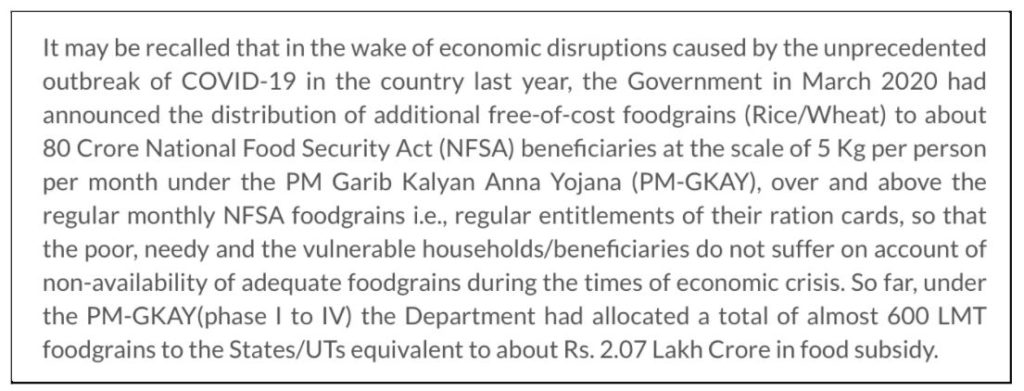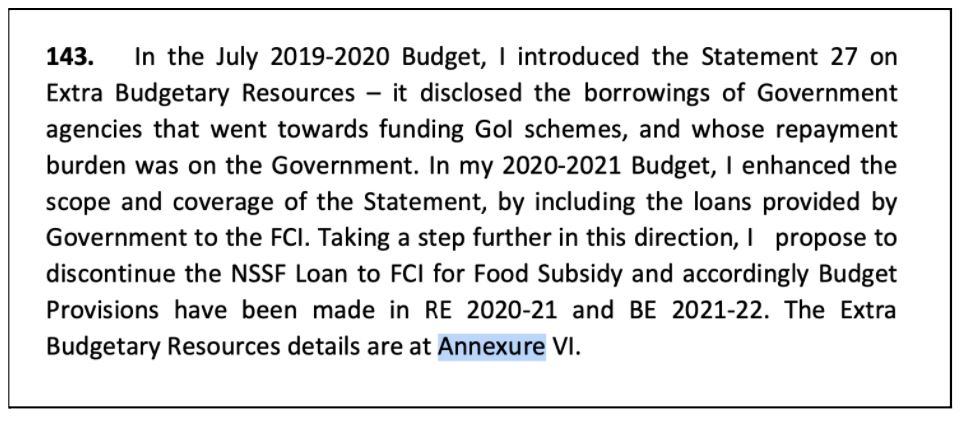For more than 20 months now, the union government has been providing additional free ration to 80 crore beneficiaries of the NFSA to tide over the effect of the pandemic. While it has been spending increased amounts on NFSA, the allocations for Mid-Day meal schemes & ICDS have reduced considerably in 2022-23.
In the earlier story, we reviewed the Union government’s budget allocation for a few major central schemes – MGNREGA, NSAP & PM-KISAN, to understand the pre & post-pandemic trends. The government used these schemes to provide livelihood support & direct financial support to the marginalised sections of the population during the pandemic.
In this story, we review a few other major schemes providing support to marginalised sectors, especially around food security.
Actual Expenditure towards Food subsidy in 2020-21 was more than Rs. 5.41 lakh crores.
Provision of food grains under Pradhan Mantri Garib Kalyan Anna Yojana (PMGKAY) was one of the key support schemes initiated by the Union government to provide relief during the pandemic. The scheme was part of the first set of measures announced by the government in March 2020 after the onset of the pandemic in the country.
The scheme was initially launched for the period April-June 2020, which was later extended multiple times. As per the latest announcement, the scheme is extended until March 2022. Under this scheme, additional 5 kgs of Rice/Wheat per month is provided free of cost to 80 crore National Food Security Act (NFSA) beneficiaries. The latest extension is the fifth phase of PMGKAY.
As per the latest update provided by the union government, during the four Phases, the total allocation of food grains to the States & UTs was almost 600 Lakh Metric Tonnes (LMT), which was worth Rs. 2.07 lakh crores.

During the fifth phase, i.e., December 2021 to March 2022, the estimated additional food subsidy is around Rs. 53.34 thousand crores for around 163 LMT.
The supply of the food grains to the states is done by the Food Corporation of India (FCI). The union government subsidizes FCI on the cost incurred for the supply of food grains under NFSA. It must be noted that PMGKAY provided additional food grains during the pandemic, and the provision of subsidized foodgrains under NFSA was already in place.
As per the data provided in the 2022-23 budget, the actual expenditure on food subsidy to FCI during 2020-21 was Rs. 4.62 lakh crores. This is higher than the revised estimate of Rs. 3.44 lakh crores, which in turn is much higher than the budget estimate made before the pandemic for Rs. 77.9 thousand crores.
Although the scheme continued in 2021-22, the revised estimate for 2021-22 is around Rs. 2.10 lakh crores, as against the budget estimate of Rs. 2.02 lakh crores. For the upcoming financial year of 2022-23, the government has made a budget allocation of Rs. 1.45 lakh crores.
Apart from the subsidy to FCI, the government has also provided a subsidy for ‘Decentralized procurement of Foodgrains under NFSA’. The actual subsidy towards this for 2020-21, was Rs. 78.3 thousand crores. Overall, as per the information provided in the budget, the government has spent Rs. 5.41 lakh crores in 2020-21 towards food subsidy including on procurement.
Apart from the increased food subsidy in the wake of the pandemic, a major change was introduced in 2021-22 about how the food subsidy is represented in the budget. The FCI is mandated to procure food grains from the farmers. It stores them and distributes them at subsidized rates under the Public Distribution System (PDS).
The loss incurred by FCI in procurement & distribution was compensated to an extent through food subsidy and mostly through the borrowings from National Small Savings Fund (NSSF).
In the budget for 2020-21, the Government of India proposed the discontinuation of the NSSF loan to FCI and made provisions for the same in the Budget.

Since the government directly did not pay the amount to FCI prior to this change, the expenditure was underreported in the earlier budgets. From the budget of 2021-22, with the change in the accounting logic, the food subsidy to FCI is being reported as an expenditure of the government.
The actual expenditure on the Mid-Day meal scheme increased during 2020-21.
The Mid-Day Meal (MDM) scheme is aimed at providing nutritious food for School-age children. As per this scheme, nutritious cooked meals are served to the school children. In September 2021, the scheme was renamed PM-POSHAN. This is a Centrally sponsored scheme and is expected to cover 11.8 crore children in 11. 2 lakh schools.

As specified, the scheme provides hot cooked meals to the children in the school premises to ensure the children get the required nutrition. The onset of the COVID-19 pandemic has resulted in the closure of schools, to prevent the spread of COVID-19 infection. This posed a challenge in continuing the scheme with the children from marginalised sections of the population being deprived of nutritious food.
Responding to the situation, the government approved an additional expenditure of Rs. 1600 crores for the MDM scheme during the summer of 2020 and an ad-hoc grant of Rs. 2.5 thousand crores were issued for the first quarter.
One of the other initiatives provided food allowance to the students which comprise of grains, pulses, oils, etc. for both primary and upper primary students. The respective State governments employed different measures in ensuring the implementation of mid-day meals to the children.
Andhra Pradesh, West Bengal, Chhattisgarh, etc were among the states that provided dry rations for the students. Karnataka utilised the Anganwadi system to distribute cooked meals to the students, while Bihar did a ‘Direct fund transfer’ to bank accounts of the parents of the children.
As per the union budget of 2022-23, the actual expenditure towards the MDM scheme in 2020-21 was Rs. 12.87 thousand crores as against Rs. 9.69 thousand crores in 2019-20. The initial budget estimate for 2020-21 was Rs.11 thousand crores, while was later revised to Rs. 12.9 thousand crores after the pandemic.
In 2021-22, Rs. 11.5 thousand crores were provided in the initial budget estimates which were later revised and reduced to Rs.10.23 thousand crores in the revised estimates. The trend over the years indicates that the actual expenditure for this scheme is always lower than the budget estimates.
Revised estimates less than the Budget estimates for ICDS scheme even during the Pandemic
The Integrated Child Development Scheme (ICDS) is a centrally sponsored scheme that is implemented by State governments and UTs. The scheme provides supplementary nutrition, immunization, and pre-school education to children. This also includes extending nutritional benefits to expecting & lactating mothers through the Anganwadi set-up in the country. ICDS is now part of Mission Poshan 2.0 (Saksham Anganwadi & Poshan 2.0) and is an integrated nutrition support program.

Like the MDM scheme, ICDS was also disrupted due to the pandemic. Apart from hampering the activities carried out in the Anganwadis, the Anganwadi workers were required to support the government’s efforts to tackle COVID-19. This has further impacted the implementation of ICDS, and the critical support needed for children & mothers.
Some state governments including Odisha & Chhattisgarh have ensured the learning of the children in home environments. The beneficiaries of the various schemes under ICDS were provided with dry ration and cooking costs to ensure access to nutritious food during the closure of Anganwadis.
The government spent much less than the budget estimates of Rs. 28.56 thousand crores for 2020-21, which was later revised to Rs. 20.04 thousand crores. The actual expenditure in 2020-21 was even lower at Rs. 18.2 thousand crores.
For 2021-22, both the revised & budget estimates were lower than for 2020-21. Unlike the other schemes, the allocation & actual expenditure was lower for ICDS even during the pandemic year.
We have considered Umbrella ICDS prior to 2021-22 and Saksham Anganwadi and Poshan from 2021-22 onwards.
Allocation for Food Security Schemes reduced for 2022-23
In view of the pandemic, the union government ramped up its efforts to provide food security to the marginalised sections of the society by providing additional food grains free of cost. Some state governments complemented these efforts by providing additional financial incentives, dry rations. This is reflected in the actual expenditure for 2020-21. However, the allocations have reduced considerably in the following years.
Considering the continued impact of the pandemic, and with research indicating that more families have been left poorer due to pandemics, it would have been prudent to spend more on these schemes which provide crucial nutritional support.
Featured Image: Budget allocation for Mid-Day Meals


